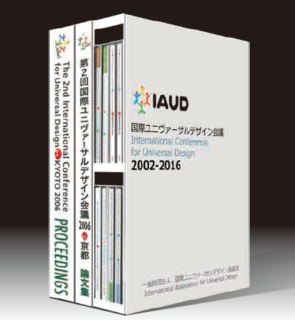2025.05.29
towards2010: From Kyoto to Hamamatsu: reflections on UD 1/3
2010.05.24 Updated
Roger Coleman
Emeritus Professor of Inclusive Design, Royal College of Art, UK
Greeting

As Editor-in-Chief of the Keynote Addresses from the IAUD International Conference on Universal Design held in Kyoto in November 2006 (ref. 1), I am in the lucky position of being able to take an overview of the status of Universal Design. Also, twelve months ago I retired from post as Co-director of the Helen Hamlyn Centre (HHC) at the Royal College of Art, London (RCA) to become Professor Emeritus of Inclusive Design. This change in my working situation has given me the freedom to think more broadly about the future of Universal Design and the new issues and challenges facing us since that very optimistic gathering in Kyoto. I would like to take this opportunity to share some of my thinking with IAUD members and supporters and also to thank the people who have helped shape my thinking and contribute to this article: HHC Research Fellows Rama Gheerawo and Yan Ki Lee; Design for All Programme Leader at the Norwegian Design Council, Onny Eikhaug; Editor of Form & Funktion, the Nordic Design for All magazine, Karin Bendixen: and Professor John Clarkson of the Engineering Design Centre at the University of Cambridge.
Design for patient safety
My new status at the RCA has freed me from official and teaching duties and allowed me to continue my involvement with the College as advisor to the HHC and several of the Centre’s research projects. I chair the advisory board to the ‘Design Out Medical Error’ (DOME) research programme, a three-year collaboration between the RCA, Imperial College London and St Mary’s Hospital Paddington. (www.domeproject.org.uk) I spoke at the Kyoto conference about the importance of patient safety and the significant potential of design to make a real difference in this area, and mentioned the work I have been engaged in, which started with a scoping study for the UK Department of Health (DoH) (refs. 2 & 3) and continued as a series of design projects on medical packaging, products and ambulance design, which can be followed up on the HHC website at (www.hhc.rca.ac.uk/291/all/1/Publications.aspx). More recently I have been involved in a collaboration with the UK Design Council on design to combat hospital acquired infections (www.designcouncil.org.uk/Design-Council/Files/Landing-pages/Design-Bugs-Out/). Some excellent work was done by the HHC team, Sally Halls and Grace Davey, who developed six innovative designs for safer everyday items of hospital equipment : an easy-clean blood pressure cuff, a time tracking for cannulars, an easy-clean clip for hospital bed curtains, and intelligent mattress that changes colour when its waterproof layer is compromised, an easy-clean pulse oximeter, and an individual patient wipe dispenser (www.hhc.rca.ac.uk/2261-2282/all/1/Designing_Bugs_Out.aspx and www.designcouncil.org.uk/Design-Council/Files/Landing-pages/Design-Bugs-Out/Everyday-equipment/).
 Wipe-clean blood pressure cuff with magnetic fastning |
 magnetic fastning 'Timestrip' time-tracker for cannulars to record time from insertion |
 Easy-clean patient-friendly pulse oximeter |

Patient antiseptic wipes for personal use
The DOME project is in many senses the culmination of past work, as it brings all those lessons and insights to bear on the reality of daily treatment in a major London teaching hospital. I brought together the research team, wrote the project proposal and secured the funding of £1.67 million for the programme. Importantly, the research team is focussing on developing an evidence base for design improvements, and I consider this as the fundamental core of the work. Earlier design projects looked at individual subjects – such as medical packaging or the resuscitation trolley – and in each case the first steps involved the gathering of an evidence base to clarify the problem, with later steps building on this and seeking to establish an evidence base for the proposed solutions. The DOME project looks beyond individual design problems to take a more systems-aware approach, where processes, people and equipment are considered in the totality of a hospital ward and in particular as they interact with each other around the patient bed-space. No matter how clever individual product design innovations may be, without this holistic approach, and without a sound evidence base linking problem and solution within the broader context of processes, people and equipment, there is no guarantee of improved patient safety. And I think the same can be said of Universal Design.
Design integration
One of my major concerns regarding Universal Design as it is practised, is that, often unwittingly, the outcome is to some extent stigmatising, and fails to transcend its historic origins in design for disability and assistive design – to use but two terms out of a multiplicity of similar expressions. In saying this I intend no criticism of design for disability and assistive products, both of which have a long and important history, but the essence of Universal and Inclusive Design lies in the seamless integration of features and solutions that allow for universal use and access without stigmatisation, which is a radically different approach. This is something that designers and manufacturers struggle with in the case of individual products, and that is only really delivered effectively when companies make Inclusive or Universal Design central to their whole philosophy, practice and consumer offer. In the Keynote Addresses Alex Lee from OXO Inc. talked eloquently about how this approach permeates the company ethos at OXO and is an essential and unifying element of the Good Grips product range. But he also made a point of saying: “Universal Design has never been a ‘marketing’ platform for the company. While we practice universal design, we do not preach it.” Instead, the Good Grips range is promoted as attractive and easy to use, as innovative and design led.
In the UK we have the example of BT (British Telecom), a leading telecommunications provider making a major internal cultural change in recent years, from being a mainstream provider with a special, and rather small, unit dedicated to older and disabled consumers, to becoming a company that has adopted Inclusive Design as a key driver in product and service development and central to its marketing strategy and whole consumer offer. Like Good Grips, BT emphasises ease of use allied to consumer benefits, not Universal Design, but internally it places great value on the ‘journey of transformation’ that the company has undertaken. That journey began in 2005, very much inspired by the British Standard on Inclusive Design Management (BS7000-6), of which I was a co-author, with a major milestone being the development of an Inclusive Design Toolkit in 2006. This was used internally by BT as part of its transformation process and eventually placed in the public domain as a website launched in July 2007 (www-edc.eng.cam.ac.uk/betterdesign/).


Copenhagen Metro
Carriage interior
© Karin Bendixen / Form & Funktion
In many senses these corporate achievements reflect the systems-level approach that I advocate for design for patient safety. Just as we need to see the seamless integration of process, people and products delivering safer healthcare through improved systems and processes, so we need to see the seamless integration of product features and ranges delivering an integrated consumer offer that is accessible to all – ideally through core products offering improved usability for all, with additional functionality and accessories to cater for the needs of specific groups of users. Again, while this may be difficult to grasp in terms of product ranges and an integrated consumer offer, it is much easier to understand when applied to public facilities and services, and we have three elegant examples of this in the Keynote Addresses from Patricia Moore, Toshimitsu Sadamura and Roger Whitehouse. In each case a whole range of elements are seamlessly and elegantly integrated to deliver a transport system or a building that is welcoming, friendly and accommodating of all users. At the heart of each of these examples is a declared intention and focus on key groups of users – older people, wheelchair users, vision impaired users – and the result is designs that work extremely well for these ‘critical’ user groups, and by extension, for mainstream users.
Other examples can be cited that were not discussed at Kyoto, from cities where there has been a serious attempt to develop a genuinely accessible urban and suburban infrastructure, such as the Copenhagen Metro, with stations designed by KHRAS Architects and trains by Giugiaro Design, and the Elephant House at Copenhagen Zoo by Norman Foster.
What we see in these exemplars is design operating as a unifying and integrating factor. Through elegant, innovative and above all thoughtful and well-researched design features, brought together in holistic solutions, we see a real step-change in quality. And it interesting to see how the designers and researchers talk about ‘good design’ ‘better design’ and ‘responsible design.’ To my mind these are the characteristics that need to be carried forward if we are to see Universal Design achieve escape velocity, transcend its past and become a real, world-changing force.
≪to be continued...≫







